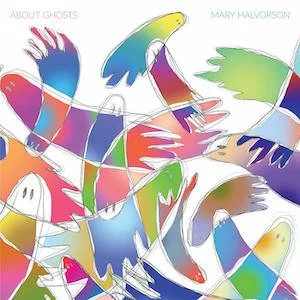Label: Nonesuch Records, 2025
Personnel - Mary Halvorson: guitar, pocket piano (#1,2,3,8); Immanuel Wilkins: alto saxophone (1,2,4,5); Brian Settles: tenor saxophone (#1,2,5,8); Adam O’Farrill: trumpet; Jacob Garchik: trombone; Patricia Brennan: vibraphone; Nick Dunston: bass; Tomas Fujiwara: drums.
Produced by Deerhoof’s John Dieterich, About Ghosts allows another worthy journey into the musical imagination of one of contemporary jazz’s most creative minds. Groundbreaking guitarist and composer Mary Halvorson presents eight originals, impeccably arranged for her widely praised Amaryllis sextet, plus two guest saxophonists: Immanuel Wilkins on alto and Brian Settles on tenor. Her remarkable talent is on full display throughout the album, where she also plays pocket piano on four tracks.
“Full of Neon” exhibits an exquisite, route-defining navigational pulse, across which unison melodies traverse unflaggingly. Jacob Garchik’s adventurous trombone solo sparks spontaneous reactions from Halvorson, while Settles’ tenor excursion unfolds over a distinct, snare-charged drum flow crafted by Tomas Fujiwara. “Carved From” opens and closes in a chamber jazz mode—horns up front—before entering a rich, uptempo waltz over which Halvorson’s atonal, provocative solo captures the ear and imagination. This is followed by Wilkins’ magnetic discourse.
“Eventual”, a somber ballad infused with mournful solemnity, spotlights vibraphonist Patricia Brennan, while the title track, “About Ghosts”, evokes an Ellingtonian movement reimagined with a 21st-century vision. Still, “Polyhedral”, with its angular, snappy theme delivered at a dazzling tempo, makes an even stronger impact. It’s a two-minute collective effort rather than a showcase for individual soloing.
Wilkins offers another improvisational blast on “Absinthian”, weaving long and fragmented phrases. This highly inventive piece, which blurs boundaries between indie electronic, alternative rock, and avant-garde jazz, stands out through its driving propulsion and fascinating counterpoint. Trumpeter Adam O’Farrill, in his eloquent yet sharply discerning style, also reveals outstanding melodic sensibility. The album concludes with “Endmost”, a 4/4 sonic mission featuring Settles and closing with Fujiwara’s drum solo over synth.
The material is unmistakably Halvorson’s. She and her constellation of superstars explore vast sonic territories without compromising accessibility, constructing intricate textures and bridging sections with both logic and audacity.
Favorite Tracks:
01 - Full of Neon ► 02 - Carved From ► 04 - Absinthian


















